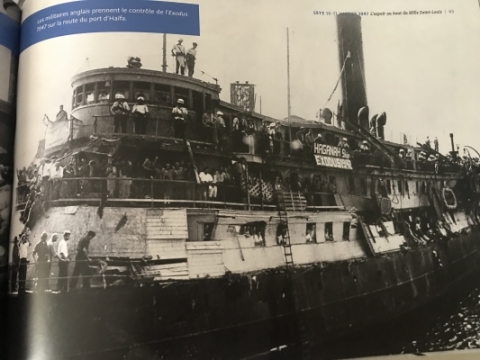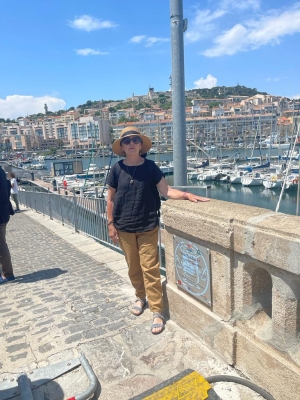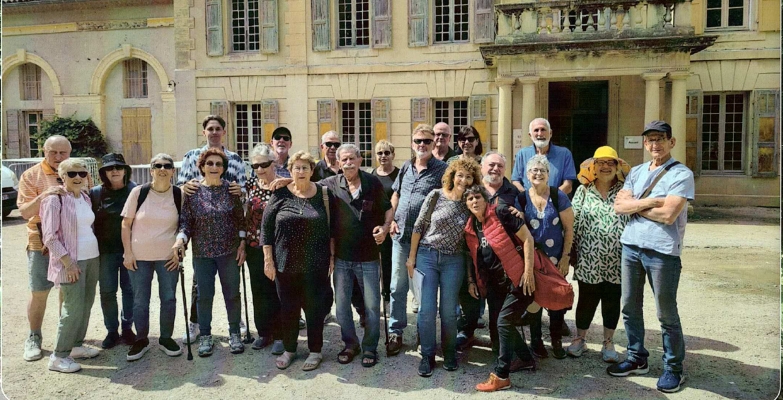In the Footsteps of Exodus 1947
 Exodus in Haifa port, after the ramming and the battle — imagine landing in Eretz Yisrael, seeing the Carmel, and then being loaded onto a prison ship
Exodus in Haifa port, after the ramming and the battle — imagine landing in Eretz Yisrael, seeing the Carmel, and then being loaded onto a prison ship
The "Real" Story
Unlike the story told in the Otto Preminger film starring Paul Newman, which is based on the book by Leon Uris, the real saga of the Exodus began in Baltimore, Maryland, in 1928, when the President Warfield was launched. A luxury excursion boat for 500 passengers, it plied the Chesapeake Bay. It was named after Solomon Davies Warfield, the president of the shipping company, whose better known niece, Wallis Warfield Simpson, was the wife of the Duke of Windsor. After doing service in WWII, the President Warfield was bought by the Haganah, refitted to carry 4,554 "illegal" immigrants – men, women, and children who had survived the Holocaust and whose only desire was to reach Palestine, where they hoped to find a true homeland.
But the British, who controlled Palestine at the time, had set a strict policy against mass Jewish immigration. They would intercept the Aliyah Bet ships near the shores of Palestine, and then ferry the refugees to Cyprus, where they had set up detention camps. Renamed Exodus in 1947, the President Warfield was the exception. British navy vessels and airplanes began following the ship shortly after it left the port of Sète in southern France on July 11, 1947. Before it entered Palestine territorial waters, British navy vessels rammed it, then boarded it and attacked its unarmed passengers with tear gas and clubs. After bravely fighting the sailors with tin cans and potatoes, their leaders surrendered. Badly damaged, it was dragged into Haifa port, where the passengers were forcibly put onto three prison ships. They were taken back to southern France, to the small port of Port-de-Bouc near Marseille, where they remained for more than three weeks. Offered French citizenship, almost no one accepted or got off the floating cages, despite the sweltering July heat and unsanitary conditions. The "illegal" immigrants were taken back to Germany, near Hamburg, where they disembarked, some by force. They were then taken by trains to camps surrounded by barbed wire in the British zone.
--------
It may have been when I was a young girl reading Leon Uris's book Exodus that my mother told me she had been one of the passengers on the "real" ship. (See box.) Ever since I have read everything I could about it and seen every documentary made about the famous ship. Reading the book and seeing the Paul Newman film, even though I knew they were fiction, captured my imagination and cemented my desire to live in Israel. So when I heard about the trip "In the Footsteps of Exodus 1947," I immediately signed up. Though the itinerary was filled with ceremonies and receptions, I dearly wanted to see the port of Sète from which the Exodus had set sail on July 11, 1947, and the other sites associated with the fateful voyage.
For us it was an adventure, for our parents it was a trauma
Our trip was organized by the Exodus Legacy Association around the dedication of two plaques in the port of Sète, one commemorating the Exodus and the other honoring Laurent Leboutet, the French commissioner of police who gave the green light for the President Warfield to weigh anchor. After introducing ourselves on the ride to Sète, about 200 kilometers from Marseille, and eating lunch together, our small group of 22 people became instant family. Most, like me, were children of Exodus passengers. But two had actually been ma'apilim, "illegal" immigrants. Pnina Gavish was twelve when she boarded the ship with her sister, and Moshe Rider had been six. On the day of the dedication ceremony, as we walked along the pier, their excitement at seeing the port 76 years after they had set sail infected us all. They shared their memories with us and more than 200 members of Sète's Jewish community and citizens of the town, as well as dignitaries, including the mayor, the regional and national presidents of CRIF (the Representative Council of Jewish Institutions in France), regional officials, and the Israeli Consul, Fares Saeb.
My mother hadn't told me much more than the dry facts about the voyage, so hearing their stories brought me closer to understanding her experiences. Pnina talked about traveling to the port in the dead of night crammed in a tarpaulin covered truck. She had been in a camp for young people, where they prepared themselves for life in Eretz Yisrael, learning agriculture and self-defense in anticipation of settling on Kibbutz Heftziba, where she lives till today. Moshe, who lives in Menahemia, remembered the trip to the port and being packed like sardines along with his parents and sister. The lines to the latrines on board the Exodus were etched in his memory. But, he said, "The British soldiers on the prison ships treated the children well and gave us sweets." Looking at it today, he said, "For us it was an adventure, for our parents it was a trauma."
The speakers, from the mayor on down, told us how proud the city and the surrounding region were about their role in helping launch the epic voyage, and noted the contribution of ordinary people, like the carpenters who helped build the bunks for the passengers. They all spoke about the immigrants and their hope, after surviving the Holocaust, of starting their lives anew in the Promised Land. Connecting the Exodus odyssey and the part played by members of the community at that time, they stressed the importance of working together to combat racism and anti-Semitism today.
I bought a copy of the book published by the local historical society, which includes photos of the passengers waiting to board the boat, getting their forged papers stamped by the French authorities, at the behest of Commissioner Laurent Leboutet. They knew who these refugees were and where they were headed, despite the false destinations and names on their documents. Dressed in heavy clothes in July and carrying bundles, it was clear that they were not headed for a pleasure cruise. The book also recounts Leboutet's role in the French resistance during WWII and his being honored as Righteous Among the Nations by Yad Vashem for his actions in relation to the Exodus.
As I stood on the pier, next to the newly inaugurated plaques, I wondered if my mother had seen only the backs of the people in front of her as she waited there before boarding the rickety President Warfield, whether she had seen only black and white, like the photos in the book, or as on this June day, the azure sea, the brightly painted houses amid the greenery on the mountain opposite, topped by the light house, whether the smell of the sea had spelled hope.
The next day, we went to Port-de-Bouc, where the three prison ships had anchored for a little more than three weeks, before the British decided to drag the survivors back to Germany. Although no one received us in Port-de-Bouc, Michelle Hasoun, our indefatigable guide, pointed out the area of the harbor where the three floating prisons had been moored, a short distance from the main street with its city hall and shops. She told us how the town's bakers had worked night and day to supply the refugees with bread, and how pharmacists and others helped provide for their needs, delivering their goods on small boats. "One of them retrieved a letter thrown to him by a passenger, who asked him to mail it to his parents, though he had no money for a stamp. Years later, the erstwhile immigrant found the letter among his parents' documents," Michelle recounted.
During the three-week standoff, the ma'apilim steadfastly resisted British pressure to get them to disembark in Port-de-Bouc, while the French authorities, who had offered them asylum, refused to force anyone off the ships. Standing on the pier of this sleepy little town, it was hard to image it swarming with spies and journalists, who had come to report about this drama.
That same day Waze took us down a tree-lined drive near Salon de Province that led to a nineteenth-century chateau. We were hoping that this was Camp Daphna, where Pnina had spent two months before boarding the Exodus. After doing some research, Yaakov Waiman, an avid historian and an Exodus Legacy Association leader, thought he had found it. Like many places that housed Jewish refugees in those days, it had been given a Hebrew name, known only by the would-be immigrants. Pnina's excitement at seeing the chateau left no doubt. It was like a dream, she said. Camp Daphna, in reality the Domaine du Merle, was an agricultural institute endowed by a Jewish banker's family in the previous century, which continues to carry out agricultural research today. The administration knows about the school's past as a way station for Jewish refugees, and graciously allowed us to use their conference room. Pnina told us about living there with and several hundred other youngsters, and about their pranks and farming lessons. Similar to other camps in the area, the Haganah used the school and grounds for military training after the refugees had left.
Listening to everyone's stories, I realized that my mother's was probably unique. Unlike her fellow passengers, she never went to a British prison camp in Germany. After disembarking from the prison ship, she was hospitalized with a stomach ailment. My father, impersonating a journalist, smuggled her out. They married in May 1948 and arrived in the US in March 1949. Almost all of the Exodus ma'apilim came to the State of Israel shortly after it was established. My mother only came on aliyah in 2008, at the age of 88, a year after my father died.
Next morning, in Marseilles, Moshe recounted the story of his brother's birth here as we stood in a plaza near an impressive church opposite the sea. Before finally sailing to the fledgling State of Israel, he and his family came here because his mother, in an advanced state of pregnancy, was not allowed to make the trip. "I remember being in a camp," he said, "or a building near the sea and next to a large church. My father bought me a bicycle. That's something that sticks out in the mind of a child." Though it fit Moshe's description, Michelle told us that this was probably not the spot, since the area had undergone renovations. She discovered the location of the "camp" after we returned to Israel. The hotel where Moshe, his family, and other refugees had been housed no longer exists, but in the late 1950s, when it reverted back to hosting vacationers, she and her family had stayed there.
Later that day we visited Camp des Milles, an internment camp near Aix-en-Provence that is France's memorial and educational equivalent of Yad Vashem. A former brick and tile factory, it had held German and Austrian citizens rounded up by the French, and then French citizens, refugees, and anti-fascists arrested by the Germans. Jews, among them children, were interned here before being deported to concentration camps in Poland. Some local residents, later declared Righteous Among the Nations, helped many of them escape and hide in the area. We were also guests of honor at the screening of a French documentary, Nous Etions l'Exodus (We were the Exodus). Before the screening, the film's director, Jean-Michel Vecchiet, answered questions from Camp des Milles staff and visitors. "My interest in the Exodus saga was aroused in Port-de-Bouc, where I would visit my grandmother. She and her friends would mention the time when the Jewish ships were anchored in the port," he explained. He began his research with Leon Uris's book, and then turned to more reliable sources, Michelle among them. Made in 2007, his documentary recounts the odyssey of the ship, with a focus on the people of Port-de-Bouc, past and present, and brings them together with some of the passengers, who came from Israel to participate in the filming. I had already seen the film at the Clandestine Immigration and Navy Museum in Haifa, but now, after standing on the piers of Sète and Port-de-Bouc, it felt much more familiar, and even more emotionally connected.
The last day of our journey took us to another small port town near Marseilles, La Ciotat. Mountains in its harbor had concealed three Aliyah Bet ships that were launched from here. Its tiny Jewish community had heard about our visit and invited us to their modest synagogue. Like the congregants in Sète, they received us warmly, and told us about their community and the towns' connection with "illegal" immigration ships. A member of our group, Dorit, talked about the "French Group" on the Exodus, 40 French speakers from Morocco, Algeria, Tunisia, Turkey, and France. The daughter of one of the group's leaders, she explained how these Zionist scouts had come to be passengers on board the famous ship. The group, including both her father and uncle, Guy and Shlomo Touboul, had been preparing themselves for life on a kibbutz in Palestine at La Roche, a hachsharah camp near Toulouse. They were approached by the Haganah to help out on the voyage, and at the same time achieve their goal of aliyah to Eretz Yisrael. (A film in Hebrew, "From Casablanca to Hamburg" recounts their story.) Little did they know what awaited them. An oddity among the passengers, they were darker skinned, and didn't know a word of Yiddish, the lingua franca on board. Yet, their knowledge of French was very helpful when it came to dealing with the authorities and tradespeople in France.
The ceremonies and receptions had turned out to be meaningful and moving. We had not come to set the memory of the Exodus in a stone on the pier in Sète, but to honor the ma'apilim, Pnina, Moshe, and our parents, the real heroes of the epic story, as Yizhak Rozman, who organized our trip, reminded us and everyone we met. (The son of Mordechai Rozman, one the leaders on the Exodus, Yizhak, is a founder of the Exodus Legacy Association.) We also learned about other heroes, Righteous Among the Nations and simple people like the French truck drivers and their union leaders, who agreed to break a strike and transport the 4,554 passengers to the port. We learned that the "ship that launched a nation" and its passengers have become an inspiration for many not just in Israel, but in France as well, which is proud of the role it played in the Exodus story.
---------------
Of all the Aliyah Bet (clandestine or "illegal" immigration) ships, the Exodus became a legend. Ruth Gruber, the journalist whose reportage was instrumental in publicizing the plight of the Holocaust survivors attempting to reach the shores of Palestine, titled her book about the historic voyage, Exodus 1947 – The Ship that Launched a Nation.* Yossi Harel, the Haganah commander of the mission, declared that "The State of Israel was not established on May 15, 1948.… It was born nearly a year earlier on July 18, 1947, when a battered and stricken American ship called the President Warfield, whose name was changed to Exodus, entered the port of Haifa with its loudspeakers blaring the strains of "Hatikva."**
* Ruth Guber, Exodus 1947 – The Ship that Launched a Nation, Times Books, 1999.
** Yoram Kaniuk, Commander of the Exodus, Grove Press, 1999.
For further reading: Murray Greenfield and Joseph Hochstein, The Jews' Secret Fleet, Gefen Publishing House, 2010.









Comments